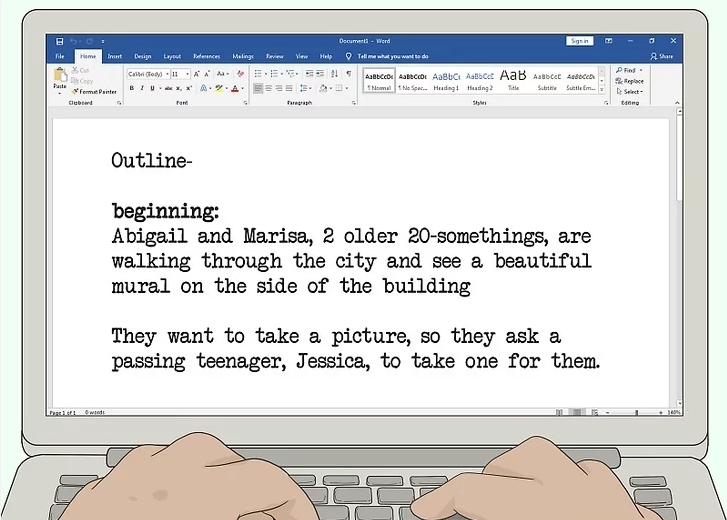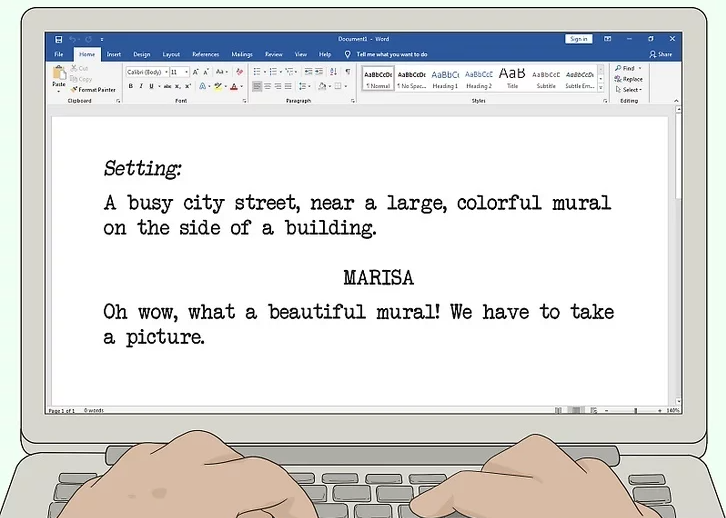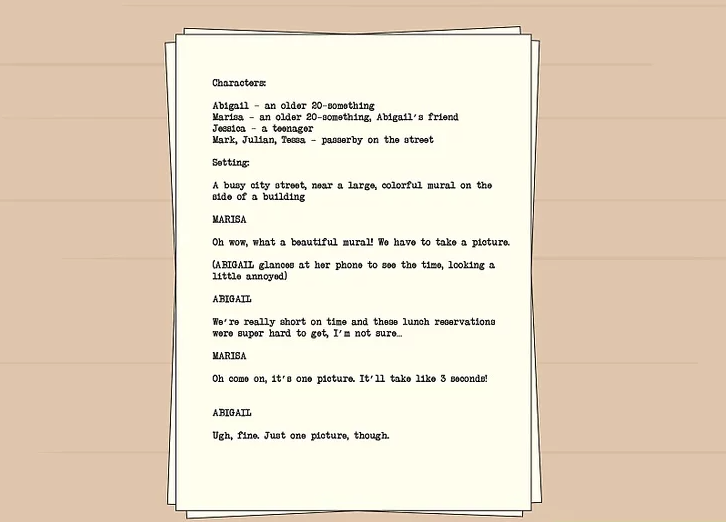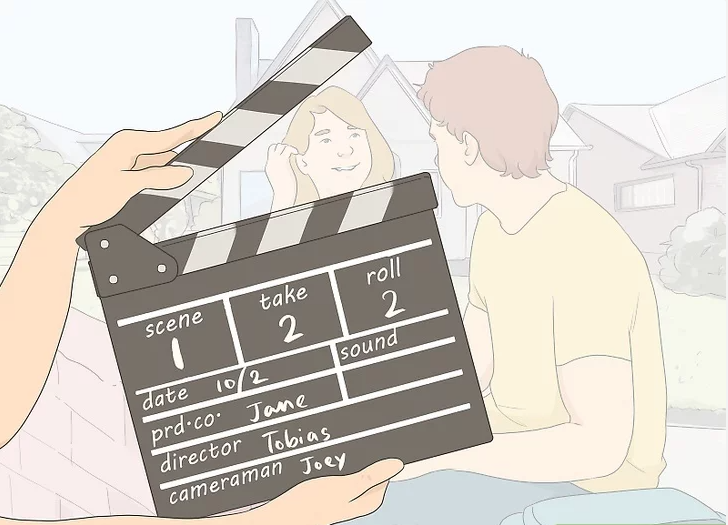您的购物车目前是空的!
How to Make a Skit A skit is a short, often humorous performance that tells a quick story or highlights a funny situation. Also known as a sketch, a skit is usually lighthearted and designed to entertain. To create one, start by brainstorming funny or relatable ideas, write out your script, rehearse your lines, and then perform it live or record it for others to enjoy.
Part1 Developing an Idea

1. Gather Inspiration
Learn from the best and observe real life for comedy ideas.
Sometimes skit ideas appear out of nowhere—but more often, you’ll need to go searching for them. Gather inspiration by watching and reading other comedy sketches. Platforms like YouTube are full of both professional and amateur sketches to study. Watch iconic shows such as Key & Peele, Saturday Night Live (SNL), W/ Bob and David, and Monty Python’s Flying Circus to see what makes their sketches stand out.
When watching, note what these professionals do well—timing, delivery, or originality. Think about what makes a sketch unique rather than copying one directly.
Also, look to your surroundings for humor. The best skits often reflect relatable everyday scenarios. Observe how people behave in coffee shops, offices, or public transport—humor is often hiding in plain sight.
References:

2. Brainstorm Ideas
Generate as many ideas as possible before narrowing them down.
Once you’re inspired, start brainstorming ideas for your skit. Write down everything that comes to mind—alone or with your team. Keep a notebook or digital note app handy so you can jot down ideas anytime inspiration strikes.
If you witness a funny interaction—like someone ordering an overly complicated drink at a café—record what made it funny. Maybe it’s the absurdity, the timing, or the attitude. Share your ideas with your group and write all suggestions in one place where everyone can see them.
Don’t filter your creativity yet. Even silly or exaggerated ideas can evolve into great sketches. When an idea makes you laugh, analyze why—it’ll help refine the humor in your final performance.
Also, think about what type of skit you want to create—parody, satire, character-based, or absurdist—each has its own comedic flavor.
References:

3. Develop Your Point of View (POV)
Establish a clear comedic message or opinion behind your skit.
Every great skit has a distinct point of view (POV)—it’s the comedic lens through which your audience sees the world. Think of your POV as your sketch’s thesis statement.
For example, if your skit is about people ordering complicated drinks, your POV might be that society has become obsessed with unnecessary choices. This idea isn’t stated outright—it’s revealed through the exaggerated behavior of your characters.
Your POV makes your skit original. Even if similar topics exist, your perspective adds authenticity and humor that no one else can replicate. Keep your POV simple, focused, and relatable—it should feel like a truth presented in a funny way.
References:

4. Outline a Beginning, Middle, and End
Structure your skit like a mini story for maximum comedic payoff.
Even short skits need structure. Outline your beginning, middle, and end before writing your dialogue.
The beginning introduces your normal world—something relatable and ordinary, like customers waiting in line at a coffee shop.
The middle introduces conflict or absurdity—maybe each person orders a drink more ridiculous than the last.
The end brings the climax and resolution—perhaps the barista finally snaps or does something wildly unexpected to end the chaos.
This structure keeps your audience engaged and ensures your skit has a satisfying punchline or twist.
References:
Part2 Writing Your Skit
How to Make a Skit (Part 2: Writing the Script)

1. Write a First Draft
Focus on getting your ideas on paper before worrying about perfection.
Start by writing a first draft of your skit. There are many ways to format a script, but the key is clarity and consistency. Begin with the title of your skit at the top, followed by a list of characters and the names of the actors (if known).
When writing dialogue, type the character’s name in all caps and center it above their lines. Indent the dialogue slightly to make it easy to read. Any actions or stage directions should be placed in parentheses on separate lines.
Don’t stress about making it perfect right away. The first draft is about getting the main idea written down—you’ll refine it later during revisions and rehearsals.
References:

2. Get Into Your Skit Quickly
Hook your audience from the very first line.
Jump right into the action. Most skits are under five minutes long, so you need to grab your audience’s attention immediately. Avoid long introductions or backstories—start your skit at the point where something funny or interesting happens.
For example, in a coffee shop sketch, begin with the barista asking the first customer for their order. This instantly tells the audience where you are, who’s speaking, and what’s going on.
Every line in your skit should matter—skip unnecessary exposition about the past or future. Focus on dialogue and actions that move the scene forward and highlight the humor.
References:

3. Keep It Short
Less is more when it comes to comedy.
Aim to keep your skit under five pages. Each page typically equals one minute of performance time. A concise skit ensures your humor stays sharp and your pacing remains tight.
If your first draft runs long, that’s fine—editing is part of the process. Focus on cutting any lines or scenes that don’t serve the main joke or theme. Remember, a quick, well-timed ending will leave your audience laughing and wanting more.
References:

4. Remember the Rule of Three
Use repetition to build rhythm and comedic impact.
Follow the classic “rule of three.” This comedy principle suggests that repeating something three times—or showing three escalating versions of a situation—creates a satisfying structure and a bigger laugh.
In your coffee shop skit, for instance, three different customers could each place increasingly ridiculous drink orders. The repetition builds anticipation, and the third instance delivers the funniest payoff.
This technique works because the audience begins to predict a pattern—then you twist it just enough to surprise them.
References:

5. Build the Action Up
Create rising tension that leads to a hilarious climax.
Make sure your skit builds momentum as it goes. Start small, then increase the intensity or absurdity with each beat. This rising action keeps your audience engaged until the punchline.
Using the coffee shop example, the first customer orders a complicated drink. The second order is even crazier, and by the time the third customer orders something impossible, the overwhelmed barista reaches their breaking point.
The climax—whether it’s an outburst, a twist, or an exaggerated reaction—should feel like a natural result of the buildup. That’s where the biggest laugh usually happens.
References:

6. Keep Working on New Drafts
Refine your skit through feedback and multiple revisions.
After finishing your first draft, read it aloud with your group. Assign roles and perform the lines to see how the dialogue sounds in real time. Comedy depends on timing, so hearing it helps identify what works and what doesn’t.
Seek honest feedback from trusted friends or collaborators. Take note of which lines made people laugh—and which didn’t. Don’t be afraid to cut jokes or moments that fall flat.
Editing is where your skit becomes sharp, funny, and efficient. Trim unnecessary dialogue and focus on making every word serve the joke or story. A lean, well-paced skit always performs better than a bloated one.
References:
Part3 Performing or Filming Your Skit

1. Hold Auditions
Find reliable and talented actors who fit your vision.
Hold auditions to find the best performers for your skit. If you’re producing your skit with a group and already know who’s acting, you can skip auditions—but always do at least one read-through together.
When holding auditions, look for actors who are not only talented but also dependable and easy to work with. Reliability is crucial since consistent attendance at rehearsals ensures smoother production.
If your skit is part of a larger school or theater event, ask your teacher or theater director for audition procedures—there may be a shared casting call. Otherwise, post audition details on bulletin boards or social media to attract participants.
During auditions, provide “sides” (short sections from your script) for actors to read and ask them to bring a headshot. This helps you match names with faces and review performances later.
References:

2. Schedule at Least One Rehearsal
Practice helps fine-tune timing, delivery, and direction.
Schedule at least one rehearsal before performing or filming. Even though skits are short, rehearsals are essential for polishing timing and ensuring everyone understands their roles and the skit’s point of view.
Go through the script scene by scene. Encourage your cast to experiment with tone and body language to find what feels most natural and funny.
Also, prepare any props or simple set pieces you might need. While skits are usually minimalist, small items—like coffee cups, hats, or signs—can make your story clearer. Make sure everyone knows how these props will be used during the performance.
References:

3. Perform or Film Your Skit
Bring your story to life through live performance or digital media.
Once your cast is ready, it’s time to perform or film your skit. If you’re performing live, double-check that your props, costumes, and lighting are all set up in advance. Arrive early to allow time for last-minute adjustments.
If you’re filming, use at least one good camera and, if possible, add sound and lighting equipment to improve quality. A simple smartphone tripod and ring light can work for smaller productions.
After recording, consider uploading your skit to YouTube or Vimeo to share it with a wider audience. Online platforms are excellent for showcasing your creativity and receiving feedback from viewers.
References: